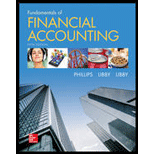
Fundamentals of Financial Accounting
5th Edition
ISBN: 9780078025914
Author: Fred Phillips Associate Professor, Robert Libby, Patricia Libby
Publisher: McGraw-Hill Education
expand_more
expand_more
format_list_bulleted
Textbook Question
Chapter 3, Problem 3.23ME
Calculating and Interpreting Net Profit Margin
Kijijo Auctions runs an online auction company. Its end-of-year financial statements indicate the following results. Calculate the company’s net profit margin expressed as a percent (to one decimal place) and indicate whether it represents an improvement or deterioration relative to the 15.0 percent net profit margin earned in the previous year.
Total assets = $100,000 Total liabilities = $60,000 Common stock = $10,000 Dividends = $5,000 Expenses = $80,000
Expert Solution & Answer
Want to see the full answer?
Check out a sample textbook solution
Students have asked these similar questions
I need help with this solution accounting question
Please explain the correct approach for solving this general accounting question.
Please help me solve this general accounting question using the right accounting principles
Chapter 3 Solutions
Fundamentals of Financial Accounting
Ch. 3 - Prob. 1QCh. 3 - When accounting was developed in the 14th and 15th...Ch. 3 - Define accrual basis accounting and contrast it...Ch. 3 - Prob. 4QCh. 3 - Prob. 5QCh. 3 - Prob. 6QCh. 3 - Explain the expense recognition principle...Ch. 3 - Explain why stockholders equity is increased by...Ch. 3 - Explain why revenues are recorded as credits and...Ch. 3 - Complete the following table by entering either...
Ch. 3 - Complete the following table by entering either...Ch. 3 - Prob. 12QCh. 3 - Prob. 13QCh. 3 - What is the difference between Accounts Receivable...Ch. 3 - What is the difference between Accounts Payable...Ch. 3 - For each of the following situations, indicate...Ch. 3 - Prob. 17QCh. 3 - Which of the following items is not a specific...Ch. 3 - Prob. 2MCCh. 3 - Prob. 3MCCh. 3 - Prob. 4MCCh. 3 - If a company incorrectly records a payment as an...Ch. 3 - Prob. 6MCCh. 3 - Prob. 7MCCh. 3 - Prob. 8MCCh. 3 - Webby Corporation reported the following amounts...Ch. 3 - Prob. 10MCCh. 3 - Prob. 3.1MECh. 3 - Identifying Accrual Basis Revenues The following...Ch. 3 - Identifying Accrual Basis Expenses The following...Ch. 3 - Recording Accrual Basis Revenues For each of the...Ch. 3 - Recording Accrual Basis Expenses For each of the...Ch. 3 - Prob. 3.6MECh. 3 - Prob. 3.7MECh. 3 - Prob. 3.8MECh. 3 - Prob. 3.9MECh. 3 - Identifying Accrual Basis Expenses The following...Ch. 3 - Prob. 3.11MECh. 3 - Recording Accrual Basis Expenses For each of the...Ch. 3 - Prob. 3.13MECh. 3 - Preparing Accrual Basis Journal Entries for...Ch. 3 - Preparing Accrual Basis Journal Entries for...Ch. 3 - Prob. 3.16MECh. 3 - Determining the Accounting Equation Effects of...Ch. 3 - Prob. 3.18MECh. 3 - Preparing an Income Statement and Calculating Net...Ch. 3 - Preparing Financial Statements from a Trial...Ch. 3 - Preparing an Income Statement and Calculating Net...Ch. 3 - Prob. 3.22MECh. 3 - Calculating and Interpreting Net Profit Margin...Ch. 3 - Prob. 3.1ECh. 3 - Matching Definitions with Terms Match each...Ch. 3 - Identifying Accrual Basis Revenues According to...Ch. 3 - Identifying Accrual Basis Revenues According to...Ch. 3 - Identifying Accrual Basis Expenses Under accrual...Ch. 3 - Identifying Accrual Basis Expenses Under accrual...Ch. 3 - Determining Accounting Equation Effects and Net...Ch. 3 - Determining Accounting Equation Effects and Net...Ch. 3 - Recording Journal Entries and Determining Net...Ch. 3 - Prob. 3.10ECh. 3 - Recording Journal Entries and Determining Net...Ch. 3 - Recording and Posting Accrual Basis Journal...Ch. 3 - Prob. 3.13ECh. 3 - Analyzing Transactions from the Perspectives of...Ch. 3 - Prob. 3.15ECh. 3 - Determining Accounting Equation Effects of Several...Ch. 3 - Preparing Journal Entries For each of the...Ch. 3 - Prob. 3.18ECh. 3 - Creating an Unadjusted Trial Balance Based on the...Ch. 3 - Inferring Transactions, Creating Financial...Ch. 3 - Determining the Effects of Various Transactions EZ...Ch. 3 - COACHED PROBLEMS Recording Nonquantitative Journal...Ch. 3 - Prob. 3.2CPCh. 3 - Prob. 3.3CPCh. 3 - Prob. 3.4CPCh. 3 - Prob. 3.1PACh. 3 - Recording Journal Entries Diana Mark is the...Ch. 3 - Analyzing the Effects of Transactions Using...Ch. 3 - Prob. 3.4PACh. 3 - Prob. 3.1PBCh. 3 - Prob. 3.2PBCh. 3 - Analyzing the Effects of Transactions Using...Ch. 3 - Analyzing, Journalizing, and Interpreting Business...Ch. 3 - Prob. 3.1COPCh. 3 - SKIL_S DEVELOPMENT CASES Finding Financial...Ch. 3 - Prob. 3.2SDCCh. 3 - Prob. 3.4SDCCh. 3 - Ethical Decision Making: A Mini-Case Mike Lynch is...Ch. 3 - Accounting for Business Operations Starting in...
Knowledge Booster
Learn more about
Need a deep-dive on the concept behind this application? Look no further. Learn more about this topic, accounting and related others by exploring similar questions and additional content below.Similar questions
arrow_back_ios
SEE MORE QUESTIONS
arrow_forward_ios
Recommended textbooks for you
 Managerial Accounting: The Cornerstone of Busines...AccountingISBN:9781337115773Author:Maryanne M. Mowen, Don R. Hansen, Dan L. HeitgerPublisher:Cengage Learning
Managerial Accounting: The Cornerstone of Busines...AccountingISBN:9781337115773Author:Maryanne M. Mowen, Don R. Hansen, Dan L. HeitgerPublisher:Cengage Learning Managerial AccountingAccountingISBN:9781337912020Author:Carl Warren, Ph.d. Cma William B. TaylerPublisher:South-Western College Pub
Managerial AccountingAccountingISBN:9781337912020Author:Carl Warren, Ph.d. Cma William B. TaylerPublisher:South-Western College Pub Survey of Accounting (Accounting I)AccountingISBN:9781305961883Author:Carl WarrenPublisher:Cengage Learning
Survey of Accounting (Accounting I)AccountingISBN:9781305961883Author:Carl WarrenPublisher:Cengage Learning

Managerial Accounting: The Cornerstone of Busines...
Accounting
ISBN:9781337115773
Author:Maryanne M. Mowen, Don R. Hansen, Dan L. Heitger
Publisher:Cengage Learning

Managerial Accounting
Accounting
ISBN:9781337912020
Author:Carl Warren, Ph.d. Cma William B. Tayler
Publisher:South-Western College Pub

Survey of Accounting (Accounting I)
Accounting
ISBN:9781305961883
Author:Carl Warren
Publisher:Cengage Learning
Financial ratio analysis; Author: The Finance Storyteller;https://www.youtube.com/watch?v=MTq7HuvoGck;License: Standard Youtube License